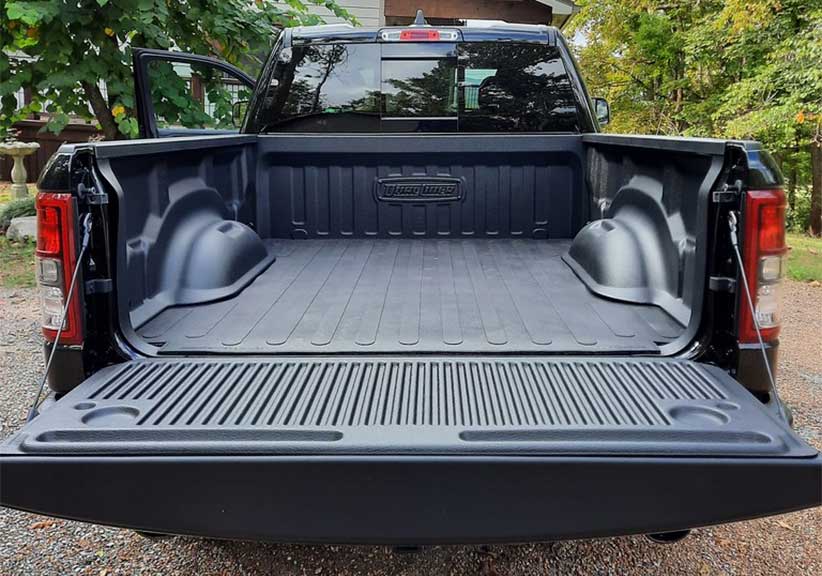Anybody who uses their truck for towing or hauling has likely heard of GVWR (Gross Vehicle Weight Rating). If you’ve never owned a truck before, or you’re new to towing, the concept of a “Gross Vehicle Weight Rating” might not make sense (yet).
If you’re hauling large loads with your truck then it’s incredibly important to understand GVWR. That’s why we’ve made this guide for anyone unfamiliar with it.

Skip to section:
WHAT IS GVWR?
Your truck’s GVWR, Gross Vehicle Weight Rating, is the heaviest your vehicle can weigh while remaining safe to drive. Another important measurement to keep in mind is “curb weight” which is your truck’s weight without cargo or occupants.
To find out how much your truck can carry, subtract its GVWR from its curb weight. For example, an ’empty’ truck may have a curb weight of 5,500 pounds and a GVWR of 7,000 pounds. Subtracting 7,000 lbs from 5,500 lbs gives you 1,500 lbs. That means you can add 1,500 pounds of extra “stuff” to your vehicle and still drive safely.
The difference between your truck’s curb weight and GVWR is not always an accurate representation of your truck’s payload. When figuring out the safest amount of cargo to put on your truck, you consider more than just your curb weight and gross vehicle weight.

Your cargo weight doesn’t just include what you’re towing, it also represents the weight of your passengers, the weight of the fuel in your tank, and the weight of any accessories attached to your truck –such as tonneau covers, toolboxes, and truck caps.
Trailers have unique requirements too. If you’re towing a trailer, you need to include the trailer’s tongue weight. (We’ll cover more of that shortly).
If you don’t know your truck’s curb weight you can check it at any weigh station. For the most accurate estimate possible, when checking your curb weight, bring along any gear you typically carry with you.
After you find your curb weight, you’ll need your GVWR rating. You can either find your truck’s GVWR on a sticker stuck to the driver’s side door frame, or you can look it up in your owner’s manual.
Once you have both measurements, do some simple math. Subtract your GVWR from the curb weight you measured. This number will tell you exactly how much you can carry, as well as how heavy your trailer’s tongue weight can be.

WHAT ABOUT YOUR TRUCK’S GCWR?
In addition to GVWR, your truck also has a GCWR: Gross Combined Weight Rating. Your GCWR adds your vehicle weight and trailer weight together. The sum gives you the maximum weight you can safely pull.
You can find the maximum weight of your trailer by subtracting your gross combined weight from your curb weight. Here’s an example. If a truck weighs 6,000 lbs, and its GCWR is 14,000 lbs, then any trailer attached to the truck must weigh 8,000 lbs or less. (14,000 GCWR – 6,000 curb weight = 8,000 for the trailer).
Again, your GCWR isn’t how much weight your truck can pull, it’s how much weight it can pull safely. Many vehicles can pull far beyond their GCWR. The problem is, the heavier a trailer is, the harder it is to control the trailer while turning or breaking. The GCWR represents the point your trailer becomes too heavy to control.
GROSS VEHICLE WEIGHT VS. CURB WEIGHT
What’s the difference between your gross vehicle and your curb weight? Gross vehicle weight includes your cargo, curb weight does not. Curb weight is your vehicle’s weight at rest; it represents your vehicle’s weight with all its standard equipment and amenities, but no cargo or passengers.
Gross vehicle weight does include the additional weight of your passengers and cargo.
If you’re using your truck to haul lots of weight, then gross vehicle weight will be incredibly important for you to understand. You’ll need to compare your gross vehicle weight to your curb weight to find your vehicle’s weight limits.

WHAT’S YOUR “TONGUE WEIGHT”?
Your truck also has a tongue weight, which represents how much force your trailer tongue can withstand. While connected to a trailer, your vehicle only carries part of the trailer’s weight, usually between 10-20%.
The percentage of a trailer’s weight you can carry depends on the trailer’s size and design. Single-axle trailers, for example, typically use a high percentage of tongue weight, but double and triple-axle trailers have fairly low tongue weight percentages.
Tongue weight works the same as cargo weight. To calculate your vehicle’s maximum capable tongue weight, compare your gross vehicle weight to your vehicle’s weight when it’s fully loaded.
What if you want to figure out how much weight your trailer tongue adds to your truck? Then take your truck and your trailer to the local weigh station. First, weigh the trailer and truck together, then disconnect the trailer and weigh your truck separately.
WHAT IS GTW?
You can find your GTW (Gross Trailer Weight) just by weighing your trailer. When you know your GTW, make sure your truck can handle a tongue weight that’s no higher than 20% of that GTW.
20% is on the high end of tongue weights, but you have some wiggle room. If your truck isn’t able to handle 20%, weigh your truck and trailer together to see if you’re under your vehicle’s GVWR.
If your tongue weight is too high, then try redistributing the weight on the trailer. You can’t dramatically change your tongue weight with this method, but it’s still important to make sure your weight is balanced when you’re towing.
WHAT CLASS OF TRAILER HITCH DO YOU NEED?
There are five different classes of hitches: I through V. These classes represent the maximum trailer weight a hitch can handle:
- Class I – up to 2,000 lbs max trailer weight
- Class II – up to 3,500 lbs max trailer weight
- Class III – up to 8,000 lbs max trailer weight
- Class IV – up to 10,000 lbs max trailer weight
- Class V – up to 20,000 lbs max trailer weight
Your hitch should be strong enough to handle the gross trailer weight of whatever you’re hauling. Towing more than you can handle might damage your hitch or vehicle frame.
If you’re in a larger hitch class, like Class IV or Class V, you’ll also want a “weight distributing hitch.” As its name suggests, this hitch evenly distributes stress across your truck frame. This makes a heavy trailer easier to control. Many newer trucks rated to pull 10,000 lbs or more include weight distributing hitch designs.
MAKING SURE YOUR TRUCK’S WEIGHT IS BALANCED
So you’ve checked your truck, trailer, and cargo’s combined weight and make sure they’re under your GVWR and GCWR. No matter how careful you’ve been, you’ll still want to make sure your cargo is evenly distributed.
Weight distribution makes a difference. For example, if you load all your weight in your truck bed, behind your rear axle, your truck’s steering will feel tighter. Or, if all your weight is piled to one side, your trailer will drift over to that side when you brake.
You can improve control over your trailer by laying out your cargo as evenly as possible. Keeping cargo spread evenly over your axles makes riding more comfortable –and safer.
You can also protect your pickup bed with truck bed liners from DualLiner. DualLiner bed liners include custom interlocking parts and a Zero Skid rubber mat. This special system is designed to fit your entire truck bed, giving you full protection from scuffs, scratches, and rust-causing moisture. Nothing beats the DualLiner truck bed liner.




